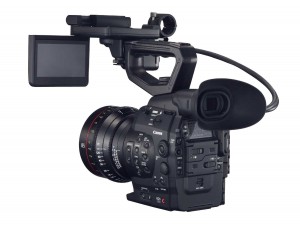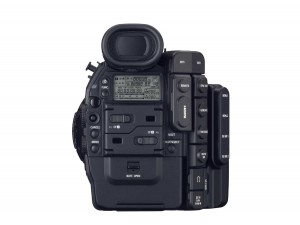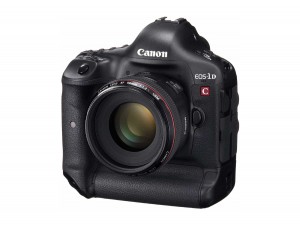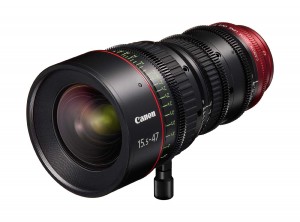
“With the unveiling of our Cinema EOS System last November to great acclaim, Canon marked our full-fledged entry into the motion-picture production market,” said Yuichi Ishizuka, executive vice president and general manager, Imaging Technologies & Communications Group, Canon U.S.A. “To further serve the needs of Hollywood’s premier filmmakers, Canon is developing the Cinema EOS C500 and Cinema EOS C500 PL digital cinematography cameras, which deliver the added benefit of full 4K motion-image capture to the Cinema EOS System.”
The C500 will be available in two versions – the Cinema EOS C500, for use with EF-mount lenses, and the Cinema EOS C500 PL for use with PL-mount lenses. The C500 cameras will be capable of originating 4K (4096 x 2160-pixel) resolution digital motion imagery with uncompressed RAW output for external recording.
“This is going to be the big brother to the C300,” said Chuck Westfall, advisor, technical information, ITC Group Professional Engineering & Solutions Division, Canon U.S.A. “It’s a new camera based on the C300 body style that can record both 4K and 2K video.”

“The 4K video is a Canon proprietary RAW format that is designed exclusively for external recorders using the 3G SDI connectors,” said Westfall. But he stressed that “the idea of this camera a is to be compatible with multiple workflow solutions for both motion picture and TV production.”
“We’re going to be cooperating with third-party vendors for compatibility with external recorders,” he explained. “Essentially, the workflow for 4K is going to go from the camera into a recorder, at that point to be developed into a DPX or OpenEXR format, which can then be accepted by the major software vendors for editing purposes.”
Users can also record a full HD proxy file at 50 Mbps 4:2:2 to the CF cards in the camera for an offline editing workflow.
The cameras are able to output quad full-HD (3840 x 2160), 2K (2048 x 1080), full HD (1920 x 1080), and other imaging options. All 4K formats feature variable frame rates from one to 60 frames per second. The cameras employ a 12-bit RGB 4:4:4 signal format during 2K output, which can also run from one to 60 fps. In 10-bit YCrCb 4:2:2 mode, the camera can run up to 120 fps.
Equipped with a newly developed Super 35mm 8.85-megapixel CMOS sensor, the cameras will be compatible with Canon’s range of interchangeable EF Cinema and PL-mount lenses and EF lenses for Canon SLR cameras.
The 4K imaging format is particularly important for big-budget motion pictures that include scenes compositing live-action cinematography with high-resolution computer-generated imagery.

The compact, lightweight EOS-1D C provides video recording at 4K (4096 x 2160-pixel) or Full HD (1920 x 1080-pixel) resolution to support high-end motion picture, television production and other advanced imaging applications.
Equipped with an 18.1-megapixel full-frame 24mm x 36mm Canon CMOS sensor, the camera records 8-bit 4:2:2 Motion JPEG 4K video to the camera’s CF memory card at 24 fps or Full HD 1920 x 1080 video at selectable frame rates from 24P to 60P.
“The Canon EOS-1D C digital SLR camera was designed in response to the needs of filmmakers, television producers, and other high-level motion-imaging professionals,” said Ishizuka. “Not only does it combine 4K and Full HD video capture with a convenient design, its use of dual CF cards also offers an efficient workflow compatible with today’s postproduction requirements.”
The Canon EOS-1D C digital SLR camera incorporates Canon Log Gamma to record high-quality video with rich gradation expression, maximizing both highlight and shadow detail retention while also providing a higher level of color-grading freedom. The EOS-1D C’s full-frame 24 x 36mm 18.1-megapixel Canon CMOS sensor makes possible a wide range of creative imaging expression, such as image-blur effects.
Additional features include an expanded sensitivity range of up to ISO 25600 for reduced noise even in low-light settings. The camera’s ability to record 8-bit 4:2:2 4K and 8-bit 4:2:0 Full HD video to CF cards eliminates the need for an external recorder and enables mobile workflows. If desired, however, captured video (excluding 4K video) can be output from the camera’s HDMI terminal to an external recorder using an uncompressed YCbCr 8-bit 4:2:2 signal.
Other useful video-related features on the EOS-1D C DSLR include a built-in headphone jack for real-time audio monitoring, and the ability to view the camera’s LCD even when the HDMI port is connected to an external monitor. The EOS-1D C camera uses the same LP-E4N battery pack as the EOS-1D X, and it can also be powered by an optional AC adapter kit.
The EOS-1D C camera ships with Canon software applications including EOS Utility, which enables various camera settings to be adjusted from a PC, and Picture Style Editor. These two personal computer applications enable users to view the camera’s live output on an external monitor and adjust the image in real-time to maximize shooting and postproduction efficiencies. The software also ensures no loss of quality for 4K/Motion JPEG and full HD/60p video displayed on the external monitor, and it enables video shot with Canon Log Gamma to be output on the monitor with video gamma applied.
The Canon EOS-1D C digital SLR camera is scheduled to be available within 2012 at a suggested retail price of $15,000.
EF Cinema Zoom Lenses

These wide-angle and telephoto cinema zooms will be compatible with industry-standard Super 35 mm-equivalent cameras and are engineered to support 4K resolution digital filmmaking.
The four lenses complement the compact body design of Canon EOS digital cinematography cameras with their own compact, lightweight design well-suited for hand-held use, or for mounting on Steadicam or other lightweight, highly mobile camera-support devices used for cinema verité, “run-and-gun” shooting, or other rapid-action filmmaking.





